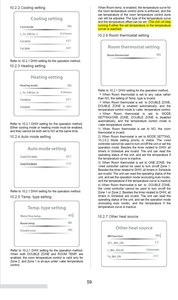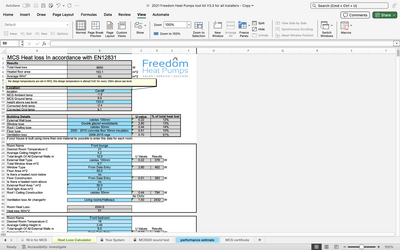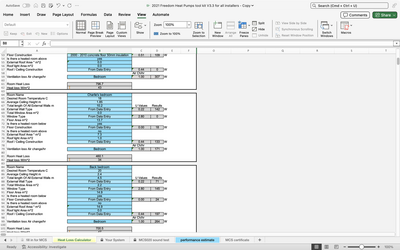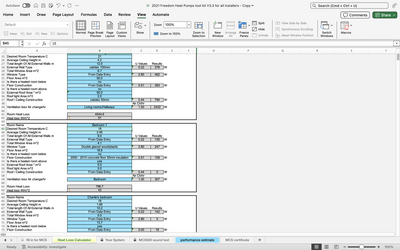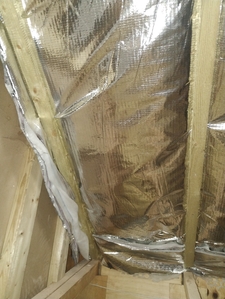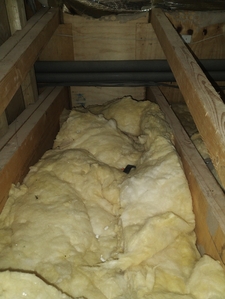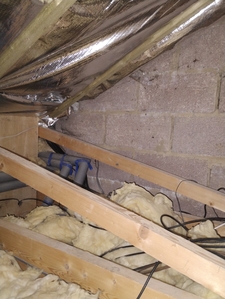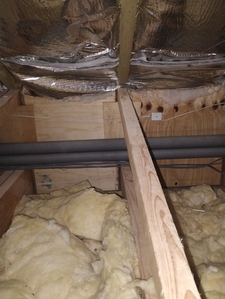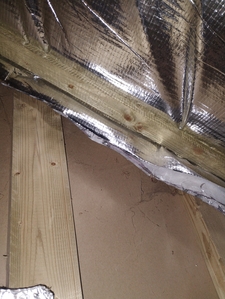Posted by: @cathoderayPosted by: @tasosThe Midea pump is controlled by its wired controller, which houses the weather compensation curve (which is straight line, but ignore this) and its internal thermostat. These two should be operated in unison. The weather curve should tell the pump the outlet water temperature corresponding to a set of outside air temperatures. So at below zero outside temperatures, I should indicate maximum power (i.e. 60-65 C in your case). The internal thermostat should be at the required room temperature in the "coldest" room, say 21 C. This implies that you should position the wired controller in the "coldest" room.
This simply isn't true. Midea heat pumps of the type we are talking about are controlled in one of two ways:
(a) using weather compensation (WC): the flow (leaving water) temp is set from the outside air temp (sensor is in the outside heat pump) using the WC curve (which I agree is a straight line, curve being used here as a generic term for a line on a graph). The internal (to the wired controller) thermostat is not used, nor any external room temp thermostats (beyond setting them high eg 30 degrees, ie always on and always calling for heat). The only exceptions are 'set-backs' and 'set-forwards' which we are not talking about here, and crude on/off switching ie turning the heat pump off for the summer by setting an external room stat low eg 10 degrees. In normal day to day running, all the control comes from the WC curve, which only uses the outside air temp.
(b) using a fixed flow temp ie there is no weather compensation, in which case some sort of indoor thermostat is used, be it the one in the wired controller if it is in a sensible place (not always the case) or an external one. This mode of running is the same mode as normally used with fossil fuel boilers in the UK, and while it can be done, it is not the best way to run a heat pump.
I think we are talking about the same type of Midea heat pumps. I attach the operation manual of mine, which in Section 10.2.5, p. 59, states what I am saying. Unless I understand wrongly.
Midea MHCV10WD2N7 R290, 4.8kW peak energy community solar power.
Posted by: @tasosThe Midea pump is controlled by its wired controller, which houses the weather compensation curve (which is straight line, but ignore this) and its internal thermostat. These two should be operated in unison. The weather curve should tell the pump the outlet water temperature corresponding to a set of outside air temperatures. So at below zero outside temperatures, I should indicate maximum power (i.e. 60-65 C in your case). The internal thermostat should be at the required room temperature in the "coldest" room, say 21 C. This implies that you should position the wired controller in the "coldest" room.
Can I just say that I dont necessarily agree with that. The problem this may cause is that it will switch off the heat pump when the air temperature in the room has reached the desired level, which in many circumstances will be before the fabric has reached equilibrium. Thus if, for example, the OAT has cooled the fabric will continue to suck heat out of the room after the room has reached temperature at a faster rate than it would in equilibrium, leading to possible failure to keep up or to oscillatory behaviour. This is somewhat house dependent, but in a well insulated house running on pure WC (or a form of adaptive WC which tweaks the WC curve slightly based on measured room temperature) is likely to lead to more stable and thus more comfortable results. I dont think the Midea features adaptive WC however.
Some simple qualitative lessons from control theory (the maths is absolutely horrid, hence qualitative only) are significant here. Systems with a lag between stimulus (turning on the heating or the OAT changing) and reaction (the IAT) can result in oscillatory behaviour. Systems where the conditions change within the timescale of the lag may never stabilise. Houses have a lag of typically 3-24 hrs and the stimulus (ie the OAT) change in a few hours.
One reason that WC works is that it effectively eliminates the lag, by reacting to OAT (which is the stimulus) rather than IAT, thus changing what the heat pump does early enough effectively to eliminate or significantly reduce the lag. And because loss is dependent principally on OAT (for a fixed IAT) the amount of stimulus is more or less perfectly matched to the requirement and thus more or less perfectly balances the loss, assuming the WC curve is correctly set.
My house noticeable exhibits oscillatory behaviour if I use any form of IAT based control which is why I run it on pure WC most of the time. Its much more stable than it ever was with thermostat based control. I depart from pure WC at the end of the season, when solar gain becomes a significant part of the energy input to the house. Then I introduce a limiting factor set a little above the target temperature and based on a representative IAT.
So I would say by all means experiment with room influence on top of WC, but start with pure WC (which also means that you get the WC set up correctly)
4kW peak of solar PV since 2011; EV and a 1930s house which has been partially renovated to improve its efficiency. 7kW Vaillant heat pump.
So, I have input details into the Freedom Heat Pumps loss calculator and I get the following
Lounge - Installer Heat Loss 40 Room Loss 1995 Mine Heat Loss 88 Room 4384
Kitchen - Installer HL 32 Room 1003 Mine HL 46 Room 1501
Bedroom 1 - Installer 22 Room 409 Mine HL 43 Room 797
Bedroom Upstairs - Installer 18 Room 247 Mine HL 34 Room 460
Their numbers are out by a factor of between 1.5 and 2.2 x
Their property loss is 8639 kW - mine is probably more like 12915 kW if I factor at the lowest multiple of 1.5 x
My last total calendar year power usage for the whole house was 11154 KwH. This includes 3 winter months where (notwithstanding potential operational inefficiencies eg no W Comp, multiple thermostats etc) usage was much lower in KwH than surrounding months where we were at home with higher thermostat temps. So if we were at home for the whole year, we would probably need at least 12500 KwH.
So where do I go now? ☹️
Posted by: @tasosI think we are talking about the same type of Midea heat pumps.
I am now even less sure we are! The manual page you posted doesn't appear in any manual I have seen for my heat pump. I also note from your footer ('signature') that your heat pump appears to be R290, mine is R32, specifically a MIDEA M-THERMAL MONO. It may be that your heat pump's control logic is different, but still the general idea is that you don't use room stats with weather compensation, because the idea is to regulate heat delivery by setting the flow temp, based on the outside air temp, rather than by on/off cycling controlled by a room stat.
Nor am I sure I really understand the paragraph with the highlighted text. Perhaps it was written or translated by some AI bot. The text in my manual isn't really much clearer, but after looking at the various screens on my wired controller, it seems it can only do pure weather compensation ie just outside air temp control, or pure fixed flow temp, with room stat control, and never a hybrid of the two.
Midea 14kW (for now...) ASHP heating both building and DHW
@pash44pump do you know your kW usage before- was it oil you said you had? I can see it shown on your scope document so was this accurate? Our estimates on our EPC were in fairness very accurate. Not sure how, as the rest of it wasn't 🤣
You can then do a quick rule of thumb calc which might help confirm your estimates versus theirs. From re-reading my research notes, I divided my kW gas usage by 2900 and then added 12% as per this youtube video:
Posted by: @pash44pumpSo where do I go now?
I suspected such a discrepancy, but we need to be 100% sure. When you say
"Lounge - Installer Heat Loss 40 Room Loss 1995 Mine Heat Loss 88 Room 4384
Kitchen - Installer HL 32 Room 1003 Mine HL 46 Room 1501"
I presume the larger numbers are the room's heat loss in watts, but I am not sure what the smaller numbers (40, 88, 32, 46) are. Can you please say what they are.
It would also be very helpful if you can post a screen grab of the calcs. That way I and others can check for errors. The more (informed) people who inspect them the better!
The other thing of course is that full area/U-value/AC calculator based heat losses tend to be over-estimates of actual heat loss, but we'll put that to one side for now.
Midea 14kW (for now...) ASHP heating both building and DHW
Posted by: @pash44pumpSo where do I go now?
Do you happen to know your annual oil consumption. This can provide a sense check.
What ach did you assume in your calcs?
4kW peak of solar PV since 2011; EV and a 1930s house which has been partially renovated to improve its efficiency. 7kW Vaillant heat pump.
Posted by: @cathoderayPosted by: @tasosI think we are talking about the same type of Midea heat pumps.
I am now even less sure we are! The manual page you posted doesn't appear in any manual I have seen for my heat pump. I also note from your footer ('signature') that your heat pump appears to be R290, mine is R32, specifically a MIDEA M-THERMAL MONO. It may be that your heat pump's control logic is different, but still the general idea is that you don't use room stats with weather compensation, because the idea is to regulate heat delivery by setting the flow temp, based on the outside air temp, rather than by on/off cycling controlled by a room stat.
Nor am I sure I really understand the paragraph with the highlighted text. Perhaps it was written or translated by some AI bot. The text in my manual isn't really much clearer, but after looking at the various screens on my wired controller, it seems it can only do pure weather compensation ie just outside air temp control, or pure fixed flow temp, with room stat control, and never a hybrid of the two.
Here is the manual:
https://www.emhbt.com/Manual/M-thermal/r290-arctic/iom-manual
In any case there is no point in continuing this discussion, as it is not going to help our friend. If he can be happy with weather compensation alone, then all is well. If however you want me to present my argumentation on the (in)effectiveness of weather compensation "control", I would be glad to discuss it in a new thread.
Midea MHCV10WD2N7 R290, 4.8kW peak energy community solar power.
@cathoderay. I've taken the numbers directly from the Freedom heat loss calculator that I downloaded from your link. This shows a room heat loss (large number) and a heat loss number W/m2 (small number). I've attached screen shots of the rooms I have done - lounge, kitchen, bedroom 1 and Charlie's bedroom (upstairs)
In the assumptions I've put External Wall celotex 100mm as I have solid brick and 100mm was the building regs requirement in 2007 (date of house build). Roof I put celotex 50mm but in the void between ceiling and roof it's mainly Triso quilt (don't know how good that is but doesn't look like it would be as good as celotex 50mm) Regs suggest 200mm for roof insulation but there is no way we have that (attached photos at the only point where I can get access to the rafters shows very little insulation). I've now updated roof downgrading to 50mm celotex but it could be worse than that. Floor construction and vent loss based on date of construction.
ACHs are as specified in the Freedom calculator that is based on room type.
Posted by: @tasosHere is the manual:
They are definitely not the same! Even with the full manual, I still can't make much sense of it. But I have just had another look at my wired controller and as far as I can see on the second menu 'PRESET TEMPERATURE' there are three items: 'PRESET TEMP', WEATHER TEMP. SET' and ECO MODE'. Selecting PRESET TEMP' sets up fixed flow temp operation, selecting 'WEATHER TEMP. SET' sets up weather compensation, and it's one or the other, they can't be combined. If on the front page, I try to change the flow temp in the left hand box, I get a message saying 'Weather temp set function is on. Do you want to turn off it? (sic)', confirming its either fixed flow or weather temp set ie weather compensation. Nor can I find anything in the manual that suggest I can somehow combine the two, which makes sense - if the flow temp is fixed, it can't be weather compensated, and if it is weather compensated, it isn't fixed.
I am still not clear about what you are trying to describe. Re-reading your earlier posts, I think what you are suggesting is have weather compensation on, but then use a room thermostat (either the one in the wired controller in the coldest room, or an external thermostat) to turn off the heating when the coldest room gets to the room stat set temperature. But (a) I am not sure what this adds over and above just getting the pipework emitters and balancing right and running only on weather compensation and (b) if you wait for the coldest room to get up to temp, what happens to the warmer rooms?
I also have the room on the longest pipe run not getting warm enough problem, running on pure weather compensation (with the room stat set very high ie always on). If I were to lower the room stat to 21 degrees and put it in the coldest room (which I can, its a wireless remote thermostat) it wouldn't do anything to warm the room up when it's cold. I am more persuaded the problem is a pipework problem, in effect there is an obstruction, but as the pipework is buried in a solid concrete floor I have no plans to start digging it up any time soon. I think some time ago I may have closed most of the other lock shield valves (I only have rads, no UFH) and it still didn't want to warm up fully. I live with it - there is some warmth from the rad, and as most of the time the doors in my house are open, warmth moves between the rooms.
Midea 14kW (for now...) ASHP heating both building and DHW
Posted by: @pash44pumpI've attached screen shots of the rooms I have done
Thanks, on a quick inspection they look sensible, but I will review again tomorrow. Others may care to comment in the mean time.
Midea 14kW (for now...) ASHP heating both building and DHW
Posted by: @tasosIn any case there is no point in continuing this discussion, as it is not going to help our friend. If he can be happy with weather compensation alone, then all is well. If however you want me to present my argumentation on the (in)effectiveness of weather compensation "control", I would be glad to discuss it in a new thread.
I see you have now added this to you post, wasn't there when I first replied. I think you have rather given the game away here, insofar as you have an agenda (the (in)effectiveness of weather compensation), and I can't help wondering if that may be part of the reason for your posts.
I think we may have discussed this (weather compensation) in the past. From my own experience, I have found it generally works well most of the time, and only goes out of whack when there are other factors in play, notably significant wind chill, but solar gain can also have an effect. I deal with this by having my 'auto-adapt' script, which tweaks the weather curve up and down when the room temp is below of above where it should be. I do appreciate this solution is not an off the shelf one for everyone, as it needs a modbus connection with a monitoring setup, plus basic python computing skills. That said, there is nothing to prevent an owner manually tweaking the weather curve settings via the wired controller, though they may find doing so might aggravate any latent HDHD (Heat pump Deficit Hyperactivity Disorder).
Midea 14kW (for now...) ASHP heating both building and DHW
Currently viewing this topic 2 users ( pash44pump, cathodeRay ) and 1 guest.
Recently viewed by users: Transparent 23 seconds ago.
- 26 Forums
- 2,153 Topics
- 47.3 K Posts
- 27 Online
- 5,673 Members
Join Us!
Podcast Picks
Latest Posts
-

RE: Midea ASHP – how to set weather compensation
@pash44pump - to collect the IAT/OAT data, can I sugges...
By cathodeRay , 5 minutes ago
-
RE: Ecodan software update. Real or scam?
@vinz86 Contact Mitsubishi and an engineer attends and ...
By ASHP-BOBBA , 10 hours ago
-
My Samsung Gen6 (probably same controller as yours) onl...
By Old_Scientist , 20 hours ago
-
@drei When I was in local government we were of cours...
By JamesPa , 20 hours ago
-
RE: Heat Pump SCOPs – The Truth Might Not Be What You Think
Sufficient system volume is also essential for ensuring...
By Old_Scientist , 22 hours ago
-

RE: Boiling Mad: Exposing Radiatorgate
@rob-nezard you can see more of Drei's rad dramas here ...
By Mars , 22 hours ago
-
RE: A Customer's Lessons Learnt from a Heat Pump Installation in a Large House
@drei I will say again that Im sorry to heat about your...
By JamesPa , 23 hours ago
-
RE: Flexi-Orb Heat Pump Scheme: A Game-Changer for the UK's Heat Pump Industry
As someone who has suffered from a Heat Pump installati...
By DREI , 1 day ago
-
RE: Solar Power Output – Let’s Compare Generation Figures
1040kw Even beat June and July. Great month.
By Andris , 1 day ago
-
RE: New Vaillant aroTherm Plus in black - When will it come to the UK?
Hope they know what they're doing regarding paint types...
By PatrickVito , 1 day ago
-

RE: What crazy nonsense are inverter limits and why are they imposed?
I’ve also got a dual fuel Rangemaster. We originally ha...
By Majordennisbloodnok , 2 days ago
-

RE: Octopus tariffs - a quick comparison
@tim441 I’d agree wholeheartedly with that, with 2 x Po...
By Toodles , 2 days ago
-
RE: Electricity price predictions
@bontwoody Maybe one for @editor to consider whether a ...
By ChandyKris , 2 days ago
-
RE: is a home battery without an EV worth it?
You would think, but when I had my Powerwall 3 installe...
By Old_Scientist , 2 days ago
-
@mars That response surely deserves a nomination for Tu...
By JamesPa , 2 days ago
-
Specifying batteries, pv solar etc using ChatGPT
I thought I'd try to use ChatGPT to specify my requirem...
By Tim441 , 3 days ago
-

RE: Ecodan & MelCloud scheduling
When I interviewed Mitsubishi Electric at Installer ear...
By Mars , 3 days ago
-

RE: Rodents! A word of warning for heat pump owners
@lucia One look at that protection and the rodents will...
By Toodles , 3 days ago

